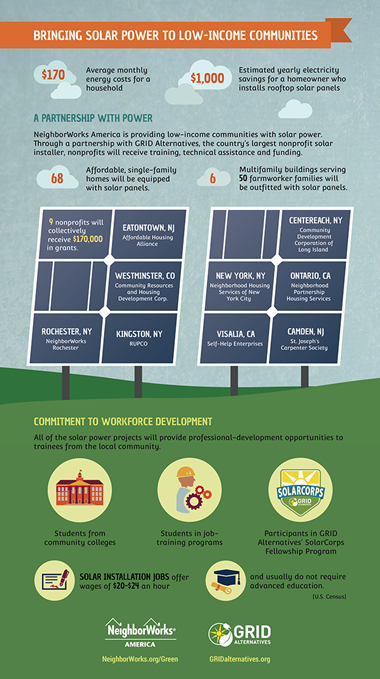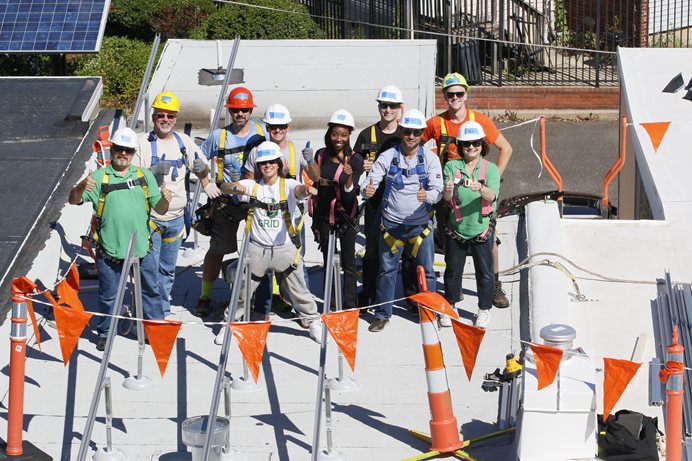Solar power is ramping up across the country as a clean, money-saving form of alternative energy. Last fall, NeighborWorks America stepped up to help expand the trend among homes for modest-income families through a partnership with GRID Alternatives, the country’s largest nonprofit solar installer. More than six months later, it’s a good time to review what types of organizations and residents can benefit the most from solar energy and the direction of the market trends.
Five market trends to watch
 Residential solar is no longer for just well-to-do homeowners. Indeed, the growth market in solar is median- and low-income neighborhoods in California and other locales, according to multiple recent reports. In 2015, for example, 65 percent of residential solar installed in California was in zip codes with median household incomes of $70,000 or less, while just 6 percent of installations in the state occurred in neighborhoods with median household incomes above $100,000, according to a report from Kevala Analytics.
Residential solar is no longer for just well-to-do homeowners. Indeed, the growth market in solar is median- and low-income neighborhoods in California and other locales, according to multiple recent reports. In 2015, for example, 65 percent of residential solar installed in California was in zip codes with median household incomes of $70,000 or less, while just 6 percent of installations in the state occurred in neighborhoods with median household incomes above $100,000, according to a report from Kevala Analytics.- Installation costs are falling as volume and competition increase. The 2016 analysis by Solar Power Rocks reduced price estimates by about 13 percent compared to the previous year.
- “Community solar” is extending the reach of sun energy to renters. Community solar refers to arrangements that allow several customers to share the benefits from one local development. According to the Solar Energies Industry Association, there are 25 states with at least one community solar project, representing 91 projects up and running and 102 cumulative megawatts generated through early 2016. At least 12 states and DC have recognized the benefits of shared renewables by encouraging their growth through policy and programs. Another trend that’s expanding is solar leasing, in which homeowners pay a fixed monthly fee for installed solar panels, rather than paying for them upfront.
- Growth in state incentives is a mixed bag. On the one hand, 2015 was the year when the first state (Hawaii) passed a 100 percent Renewable Portfolio Standard (the proportion of overall energy produced from renewable sources) and another state (Vermont) approved a goal of 75 percent. On the other hand, however, there also have been some disappointments: West Virginia and Kansas, for example, repealed their RPS laws and other state legislatures are considering doing the same. Likewise, more than half of the states are studying or changing net-metering policies, often in response to lobbyists for big electricity companies or the utility industry. (Net metering works by crediting solar energy system owners for the electricity they add back to the grid. For example, if a resident’s system generates more electricity than the home uses during daylight hours, the extra is sold back and he or she receives a credit.) Fortunately, in December, Congress extended the Federal Investment Tax Credit, which gives solar owners 30 percent of their costs back as a tax credit.
- Solar jobs are growing, making it a good target for workforce development. The latest National Solar Jobs Census found that the more than 35,000 workers joined the industry in 2015, a 20 percent increase in growth from the previous year. Employment in solar grew 12 times faster than the national average job growth. This is good news for GRID, which partners with green-jobs training programs to give students hands-on experience during its installations, and helps them obtain solar jobs.
Four lessons learned
Under the GRID-NeighborWorks partnership, solar electrical systems are being installed on 63 single-family homes for low-income families and one multi-family development with six buildings and 50 units. It is estimated that 113 families will “go solar” as a result, eliminating 5,700 tons of greenhouse gas emissions; the typical homeowner is expected to save more than $1,000 a year on electricity (often between half and three quarters of their bills). |
| The GRID crew in Camden, NJ |
If your organization or another community player is considering investing in solar, consider these pointers from some of our project leaders:
- “Make sure you have sufficient roof space and good access to it,” advises Felix Torres-Colon, director of operations at St. Joseph’s Carpenter Society in Camden, NJ. “We develop row houses in a dense urban neighborhood, and the solar panels take up a space about the size of two or three car spaces. And getting on top of the roof requires a very big ladder—which some people aren’t comfortable with.” Tim Sears, GRID co-founder and chief operating officer, adds that it’s best to install solar when the roof is relatively new and in good shape.
- “If your city hasn’t had much solar development yet, build in time for education and customizing the design,” adds Carly Johansson, who directs real estate for Colorado’s Community Resources and Housing Development Corp. “Usually, we locate our solar panels on the most prominent roof in a multi-family development, and use one collective meter to measure use. However, the city of Ft. Morgan insisted on per-unit metering, which required a re-design. And the fire department wanted a four-foot walkway around the panels. This all required a lot of education and discussion. It’s worth it though; in our experience, solar generally outperforms your expectations.”
- “Pay attention to the sun and shade,” Sears says. “The roof must be pointing in the right direction—south- or west-facing—and there shouldn’t be any big trees or buildings that will block the sun.”
- “The higher the local electricity bills, and the better the financing and incentives available in your state, the more solar makes sense,” concludes Sears. GRID recently announced a new technical-assistance service, free to multi-family housing owners, managers and developers, to help them navigate complex financing, regulatory and other issues so they can put solar on their buildings. To check out the situation in your state, you also may consult the 2016 rankings from Solar Power Rocks.

